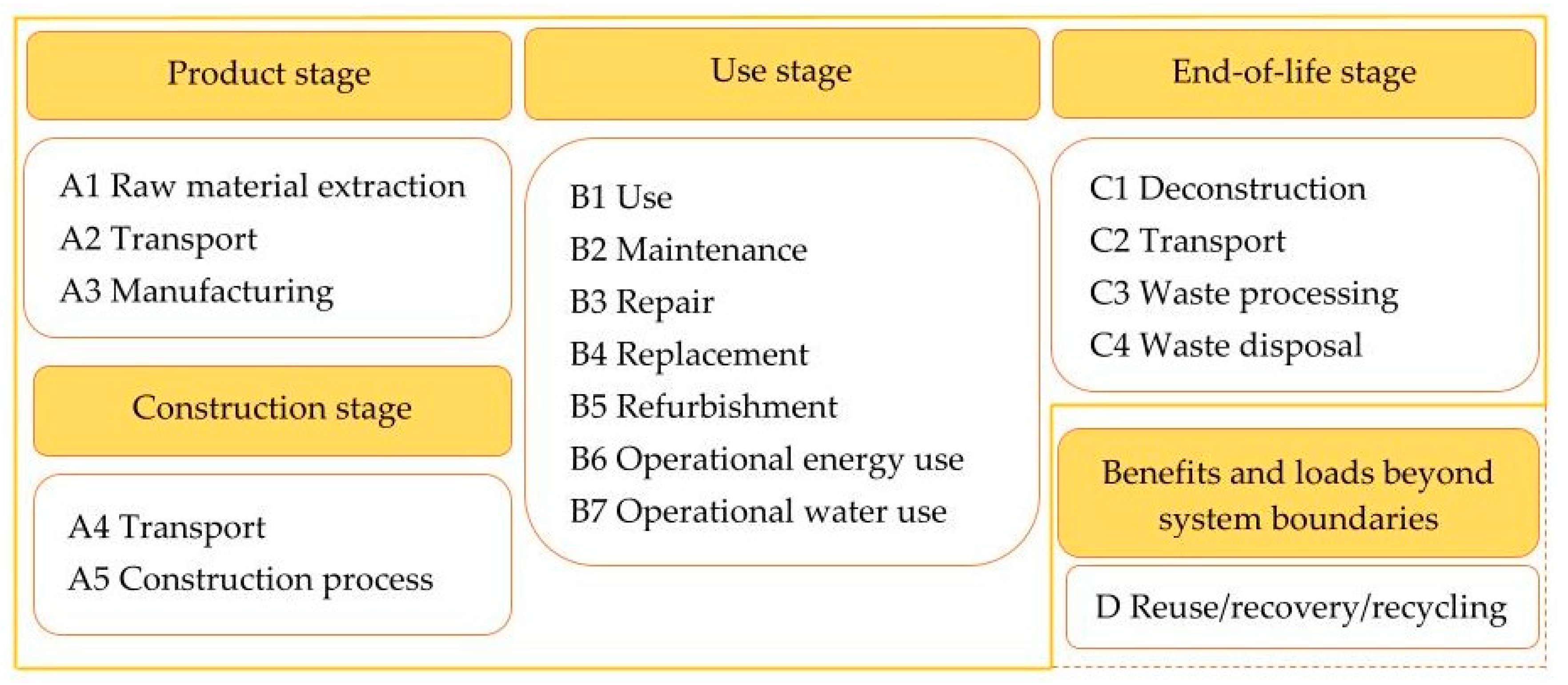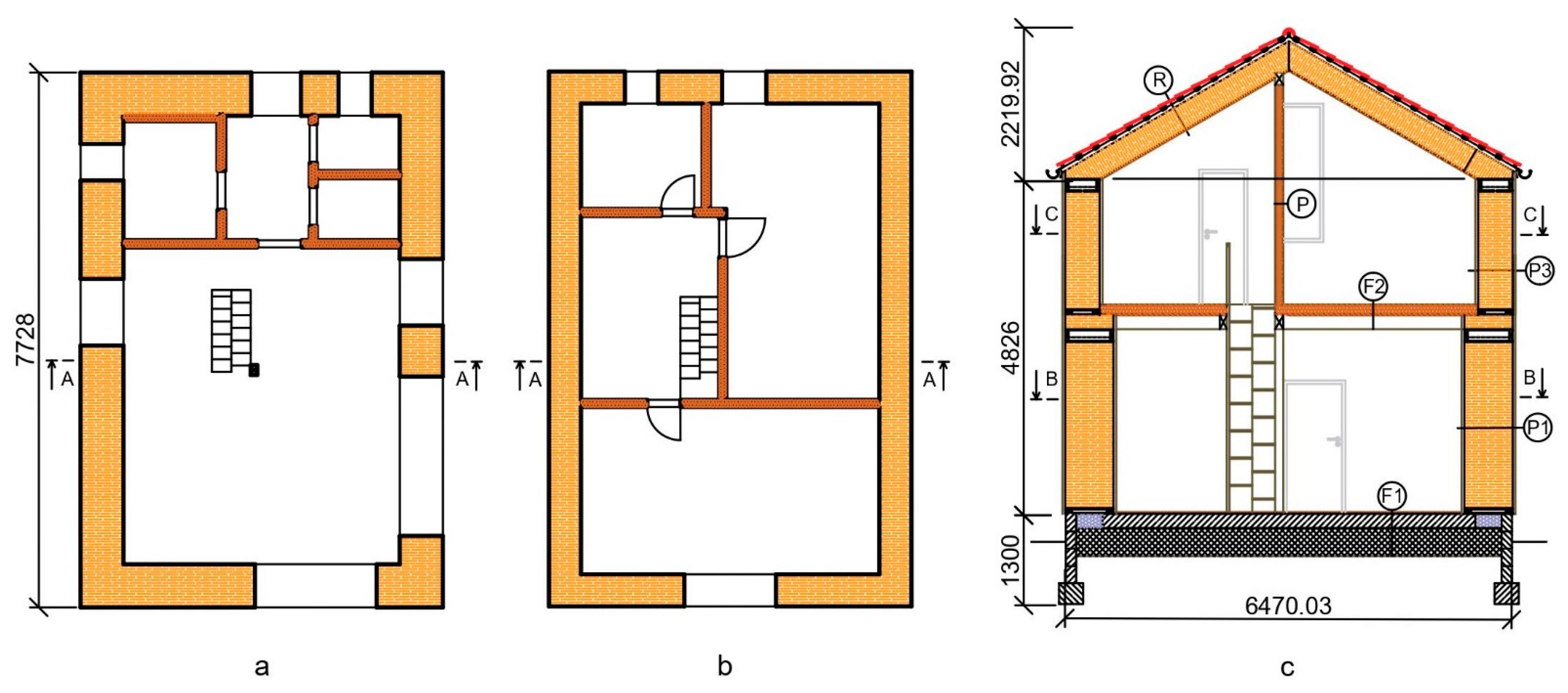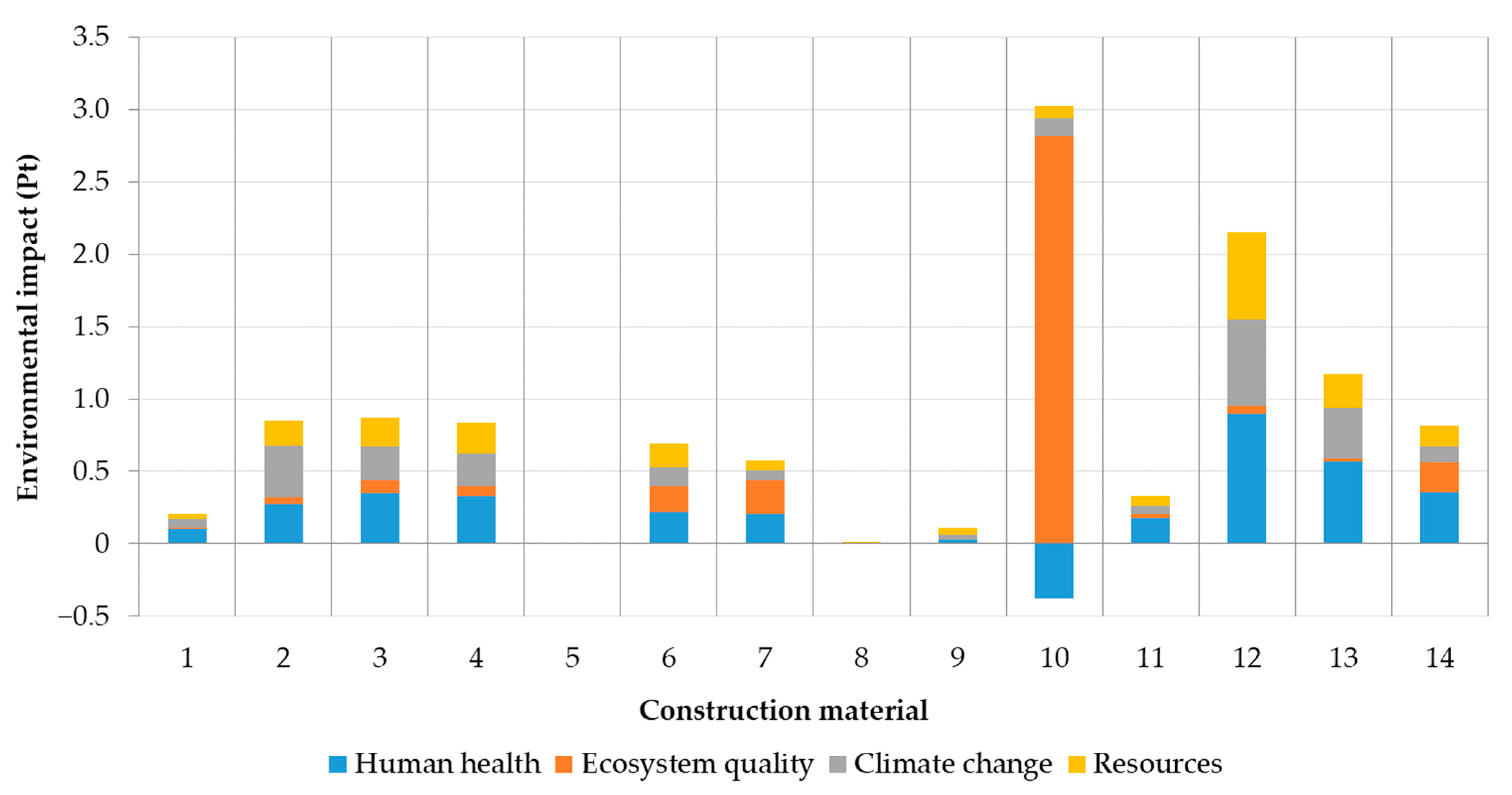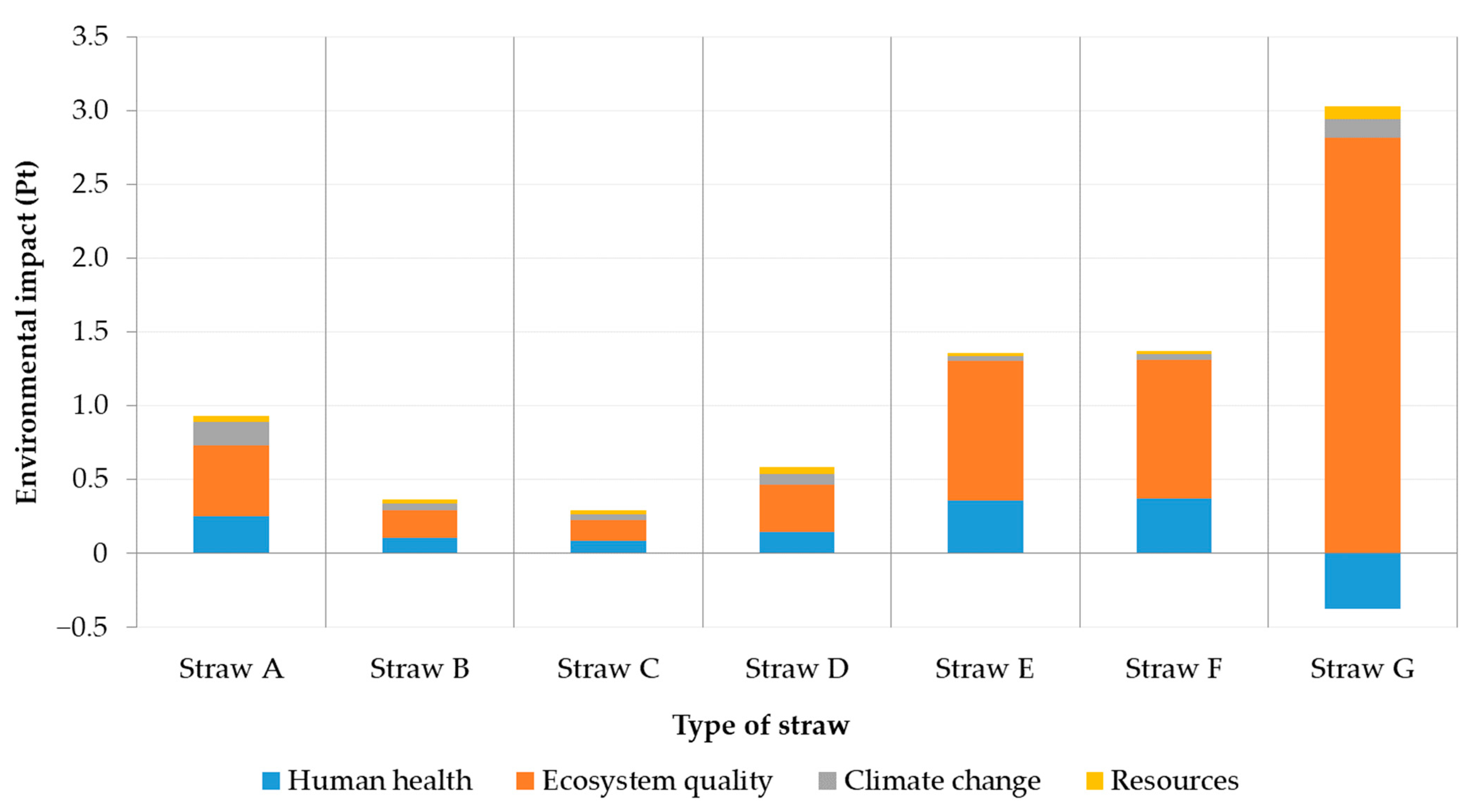Life Cycle Impact Assessment of Load-Bearing Straw Bale Residential Building
Abstract
1. Introduction
1.1. Environmental Impact and Life Cycle Assessment
1.2. Straw as a Construction Material
2. Materials and Methods
3. Results
4. Discussion
5. Conclusions
Author Contributions
Funding
Institutional Review Board Statement
Informed Consent Statement
Data Availability Statement
Acknowledgments
Conflicts of Interest
Appendix A
| Material | Impact Category | ||||||||||||||
|---|---|---|---|---|---|---|---|---|---|---|---|---|---|---|---|
| Carcinogens | Non-Carcinogens | Respiratory Inorganics | Ionizing Radiation | Ozone Layer Depletion | Respiratory Organics | Aquatic Ecotoxicity | Terrestrial Ecotoxicity | Terrestrial Acid/Nutri | Land Occupation | Aquatic Acidification | Aquatic Eutrophication | Global Warming | Non-Renewable Energy | Mineral Extraction | |
| (kg C2H3Cl eq) | (kg C2H3Cl eq) | (kg PM2.5 eq) | (Bq C-14 eq) | (kg CFC-11 eq) | (kg C2H4 eq) | (kg TEG eq) | (kg TEG eq) | (kg SO2 eq) | (m2eq Organic Arable Land·Year) | (kg SO2 eq) | (kg PO43− eq) | (kg CO2 eq) | (kg oil eq) | (kg Fe eq) | |
| 1 * | 38.65 | 1.60 | 9.60 | 3.69 | 2.42 | 23.93 | 1.66 | 0.42 | 8.31 | 0.01 | 8.64 | 5.37 | 9.70 | 5.96 | 17.50 |
| 1 ** | 28.69 | 22.81 | 0.81 | 21.80 × 102 | 2.77 × 10−5 | 0.41 | 45.29 × 103 | 15.00 × 103 | 8.15 | 6.37 | 2.23 | 0.17 | 571.91 | 53.95 × 102 | 97.24 |
| 2 * | 26.64 | 3.34 | 29.95 | 29.68 | 18.28 | 45.08 | 4.88 | 1.69 | 53.10 | 0.14 | 39.76 | 11.09 | 59.99 | 28.30 | 13.12 |
| 2 ** | 19.78 | 47.76 | 2.52 | 17.55 × 103 | 2.10 × 10−4 | 0.77 | 13.32 × 104 | 60.30 × 103 | 52.10 | 85.44 | 10.25 | 0.34 | 35.35 × 102 | 25.60 × 103 | 72.90 |
| 3 * | 28.17 | 4.35 | 38.04 | 28.43 | 10.93 | 34.88 | 14.02 | 3.50 | 39.97 | 0.25 | 49.49 | 15.94 | 39.14 | 33.15 | 3.47 |
| 3 ** | 20.91 | 62.12 | 3.20 | 16.81 × 103 | 1.25 × 10−4 | 0.60 | 38.27 × 104 | 12.47 × 104 | 39.21 | 151.38 | 12.76 | 0.49 | 23.07 × 102 | 29.99 × 103 | 19.29 |
| 4 * | 29.66 | 2.78 | 36.67 | 31.98 | 24.95 | 59.40 | 6.25 | 2.78 | 58.34 | 0.13 | 47.72 | 11.61 | 37.33 | 36.03 | 11.83 |
| 4 ** | 22.02 | 39.68 | 3.09 | 18.91 × 103 | 2.86 × 10−4 | 1.02 | 17.08 × 104 | 99.12 × 103 | 57.24 | 81.55 | 12.30 | 0.36 | 22.00 × 102 | 32.59 × 103 | 65.73 |
| 5 * | 0.10 | 0.01 | 0.17 | 0.19 | 0.21 | 0.50 | 0.05 | 0.01 | 0.24 | 0.00 | 0.32 | 0.07 | 0.20 | 0.31 | 0.01 |
| 5 ** | 0.08 | 0.19 | 0.01 | 109.35 | 2.44 × 10−6 | 8.61 × 10−3 | 13.48 × 102 | 364.35 | 0.23 | 0.33 | 0.08 | 2.27 × 10−3 | 11.46 | 275.84 | 0.08 |
| 6 * | 57.83 | 3.37 | 22.12 | 19.16 | 9.36 | 100.00 | 10.74 | 2.99 | 37.97 | 2.23 | 30.60 | 10.58 | 22.11 | 27.86 | 9.60 |
| 6 ** | 42.93 | 48.12 | 1.86 | 11.33 × 103 | 1.07 × 10−4 | 1.72 | 29.32 × 104 | 10.64 × 104 | 37.25 | 13.68 × 102 | 7.89 | 0.33 | 13.03 × 102 | 25.20 × 103 | 53.37 |
| 7 * | 12.19 | 1.26 | 23.77 | 12.16 | 6.83 | 34.76 | 3.56 | 1.07 | 22.96 | 4.19 | 16.90 | 4.53 | 11.55 | 11.17 | 3.04 |
| 7 ** | 9.05 | 17.93 | 2.00 | 71.94 × 102 | 7.84 × 10−5 | 0.60 | 97.07 × 103 | 38.10 × 103 | 22.52 | 25.71 × 102 | 4.36 | 0.14 | 680.86 | 10.10 × 103 | 16.92 |
| 8 * | 0.12 | 0.02 | 0.25 | 0.28 | 0.06 | 2.03 | 0.04 | 0.01 | 0.43 | 0.00 | 0.38 | 0.06 | 0.47 | 0.81 | 0.03 |
| 8 ** | 0.09 | 0.27 | 0.02 | 168.18 | 7.33 × 10−7 | 0.03 | 10.51 × 102 | 255.44 | 0.42 | 0.39 | 0.10 | 1.95 × 10−3 | 27.39 | 731.95 | 0.19 |
| 9 * | 9.70 | 0.15 | 2.59 | 1.78 | 100.00 | 14.45 | 0.25 | 0.05 | 3.65 | 0.00 | 4.21 | 1.13 | 6.20 | 7.41 | 0.83 |
| 9 ** | 7.20 | 2.13 | 0.22 | 10.54 × 102 | 1.15 × 10−3 | 0.25 | 68.18 × 102 | 18.75 × 102 | 3.58 | 1.31 | 1.08 | 0.03 | 365.40 | 67.02 × 102 | 4.62 |
| 10 * | 15.09 | −100.00 | 21.87 | 10.94 | 10.99 | 41.46 | −100.00 | −100.00 | 37.83 | 100.00 | 24.83 | 100.00 | 20.47 | 14.50 | 9.86 |
| 10 ** | 11.20 | −14.29 × 102 | 1.84 | 64.72 × 102 | 1.26 × 10−4 | 0.71 | −27.30 × 105 | −35.61 × 105 | 37.12 | 61.34 × 103 | 6.40 | 3.08 | 12.06 × 102 | 13.11 × 103 | 54.83 |
| 11 * | 18.98 | 0.97 | 20.22 | 8.66 | 6.12 | 51.22 | 2.57 | 0.69 | 14.81 | 0.26 | 14.23 | 3.83 | 8.90 | 11.39 | 4.24 |
| 11 ** | 14.09 | 13.84 | 1.70 | 51.19 × 102 | 7.02 × 10−5 | 0.88 | 70.29 × 103 | 24.64 × 103 | 14.53 | 156.87 | 3.67 | 0.12 | 524.69 | 10.30 × 103 | 23.57 |
| 12 * | 100.00 | 5.66 | 100.00 | 100.00 | 35.75 | 62.76 | 14.33 | 2.08 | 100.00 | 0.19 | 100.00 | 73.05 | 100.00 | 100.00 | 99.33 |
| 12 ** | 74.23 | 80.84 | 8.42 | 59.14 × 103 | 4.10 × 10−4 | 1.08 | 39.13 × 104 | 74.14 × 103 | 98.11 | 115.53 | 25.78 | 2.25 | 58.93 × 102 | 90.45 × 103 | 552.07 |
| 13 * | 91.04 | 10.13 | 58.36 | 14.19 | 9.05 | 14.69 | 6.74 | 0.77 | 58.14 | 0.00 | 82.27 | 13.54 | 58.71 | 37.77 | 100.00 |
| 13 ** | 67.58 | 144.79 | 4.91 | 83.90 × 102 | 1.04 × 10−4 | 0.25 | 18.41 × 104 | 27.32 × 103 | 57.05 | 27.27 | 21.21 | 0.42 | 34.60 × 102 | 34.16 × 103 | 555.82 |
| 14 * | 42.05 | 4.57 | 38.31 | 39.25 | 13.59 | 89.73 | 16.41 | 4.54 | 38.54 | 2.13 | 28.33 | 14.12 | 18.72 | 24.27 | 8.76 |
| 14 ** | 31.22 | 65.28 | 3.23 | 23.21 × 103 | 1.56 × 10−4 | 1.54 | 44.78 × 104 | 16.18 × 104 | 37.81 | 13.08 × 102 | 7.30 | 0.43 | 11.04 × 102 | 21.95 × 103 | 48.71 |
References
- Rissman, J.; Bataille, C.; Masanet, E.; Aden, N.; Morrow, W.R.; Zhou, N.; Elliott, N.; Dell, R.; Heeren, N.; Huckestein, B.; et al. Technologies and policies to decarbonize global industry: Review and assessment of mitigation drivers through 2070. Appl. Energy 2020, 266, 114848. [Google Scholar] [CrossRef]
- World Economic Forum. The Global Risks Report. 2020. Available online: https://www.weforum.org/reports/the-global-risks-report-2020 (accessed on 2 October 2020).
- Corbett, J. Massive ‘Climate Clock’ Urging Governments to #ActInTime Unveiled on Metronome in New York City. Common Dreams. 2020. Available online: https://www.commondreams.org/news/2020/09/19/massive-climate-clock-urging-governments-actintime-unveiled-metronome-new-york-city (accessed on 10 October 2020).
- ISO 14040:2006 Environmental Management. Life Cycle Assessment-Principles and Framework; International Organization for Standardization: Geneva, Switzerland, 2006.
- ISO 14044:2006+A1:2018 Environmental Management. Life Cycle Assessment-Requirements and Guidelines; International Organization for Standardization: Geneva, Switzerland, 2006.
- EN 15804:2012+A2:2019 Sustainability of Construction Works-Environmental Product Declarations-Core Rules for the Product Category of Construction Products; European Committee for Standardization: Bruxelles, Belgium, 2012.
- Jolliet, O.; Margni, M.; Charles, R.; Humbert, S.; Payet, J.; Rebitzer, G.; Rosenbaum, R. IMPACT 2002+: A new life cycle impact assessment methodology. Int. J. Life Cycle Assess. 2003, 8, 324–330. [Google Scholar] [CrossRef]
- Ghaffar, S.H. Straw fibre-based construction materials. In Advanced High Strength Natural Fibre Composites in Construction; Fan, M., Fu, F., Eds.; Woodhead Publishing: Cambridge, UK, 2017; pp. 257–283. [Google Scholar] [CrossRef]
- Muazu, A.G.; Alibaba, H.Z. The Use of Traditional Building Materials in Modern Methods of Construction. IJESTR 2017, 2, 30–40. [Google Scholar]
- Bhattarai, P.; Dhakal, D.R.; Neupane, K.; Chamberlin, K.S. Straw Bale in Construction of Building and its future in India. IJMER 2012, 2, 422–426. [Google Scholar]
- Ashour, T.; Wu, W. Using Barley Straw as Building Material. In Barley: Production, Cultivation and Uses; Elfson, S.B., Ed.; Nova Science Publishers Inc.: Hauppage, NY, USA, 2011; 28p. [Google Scholar]
- Dzidic, S. Fire Resistance of the Straw Bale Walls. In Contemporary Achievements in Civil Engineering, Proceedings of the 5th International Conference, Subotica, Serbia, 21 April 2017; Faculty of Civil Engineering Subotica of the University of Novi Sad: Subotica, Serbia, 2017. [Google Scholar] [CrossRef]
- Petkova-Slipets, R.; Zlateva, P. Thermal Insulating Properties of Straw-Filled Environmentally Friendly Building Materials. Civ. Environ. Eng. 2017, 13, 52–57. [Google Scholar] [CrossRef]
- Costes, J.-P.; Evrard, A.; Biot, B.; Keutgen, G.; Daras, A.; Dubois, S.; Lebeau, F.; Courard, L. Thermal Conductivity of Straw Bales: Full Size Measurements Considering the Direction of the Heat Flow. Buildings 2017, 7, 11. [Google Scholar] [CrossRef]
- Sabapathy, K.A.; Gedupudi, S. Straw bale based constructions: Measurement of effective thermal transport properties. Constr. Build. Mater. 2019, 198, 182–194. [Google Scholar] [CrossRef]
- Teslík, J.; Fabian, R.; Hrubá, B. Determination of the Airborne Sound Insulation of a Straw Bale Partition Wall. Civ. Environ. Eng. 2017, 13, 20–29. [Google Scholar] [CrossRef][Green Version]
- Cascone, S.; Evola, G.; Gagliano, A.; Sciuto, G.; Parisi, C.B. Laboratory and In-Situ Measurements for Thermal and Acoustic Performance of Straw Bales. Sustainability 2019, 11, 5592. [Google Scholar] [CrossRef]
- Koh, C.H.; Kraniotis, D. Hygrothermal performance, energy use and embodied emissions in straw bale buildings. Energy Build. 2021, 245, 111091. [Google Scholar] [CrossRef]
- Marques, B.; Tadeu, A.; Almeida, J.; António, J.; de Brito, J. Characterisation of sustainable building walls made from rice straw bales. J. Build. Eng. 2020, 28, 101041. [Google Scholar] [CrossRef]
- Allam, M.E.; Garas, G.L.; El Kady, H.G. Recycled chopped rice straw- cement bricks: Mechanical, fire resistance & economical assessment. Aust. J. Basic Appl. Sci. 2011, 5, 27–33. [Google Scholar]
- European Straw Building Association. Available online: https://strawbuilding.eu/ (accessed on 25 May 2021).
- Cornaro, C.; Zanella, V.; Robazza, P.; Belloni, E.; Buratti, C. An innovative straw bale wall package for sustainable buildings: Experimental characterization, energy and environmental performance assessment. Energy Build. 2020, 208, 109636. [Google Scholar] [CrossRef]
- González, A.D. Energy and carbon embodied in straw and clay wall blocks produced locally in the Andean Patagonia. Energy Build. 2014, 70, 15–22. [Google Scholar] [CrossRef]
- Abd-Elhafeez, M.; Ali, N.; Elrayies, G.; Eid, Y. Impact Assessment of Reused Straw Bales as Alternative Building Materials. Port-Said Eng. Res. J. 2015, 19, 56–64. [Google Scholar] [CrossRef]
- Nozdrovicky, L.; Macak, M.; Maga, J. Evaluation of the technical and economical effects of the using of machinery system for processing of straw for energy purposes. Agric. Eng. Int. CIGR J. 2015, 2015, 200–207. [Google Scholar]
- International Energy Agency. Global Status Report for Buildings and Construction 2019. IEA: Paris, France. Available online: https://www.iea.org/reports/global-status-report-for-buildings-and-construction-2019 (accessed on 28 May 2021).
- STN 73 0540-3:2012 Thermal Protection of Buildings. Thermal Performance of Buildings and Components. In Part 3: Properties of Environments and Building Products; Slovak Technical Standards: Bratislava, Slovakia, 2012.
- Ecoinvent v3.4. 2017. Available online: https://www.ecoinvent.org/database/older-versions/ecoinvent-34/ecoinvent-34.html (accessed on 5 September 2020).
- Haas, G.; Wetterich, F.; Köpke, U. Comparing intensive, extensified and organic grassland farming in southern Germany by process life cycle assessment. Agric. Ecosyst. Environ. 2001, 83, 43–53. [Google Scholar] [CrossRef]
- Petrovic, B.; Myhren, J.A.; Zhang, X.; Wallhagen, M.; Eriksson, O. Life cycle assessment of a wooden single-family house in Sweden. Appl. Energy 2019, 251, 113253. [Google Scholar] [CrossRef]
- Mitterpach, J.; Ileckova, R.; Stefko, J. Life cycle impact assessment of construction materials of a wood-based building in an environmental context. Acta Fac. Xylologiae 2018, 60, 147–157. [Google Scholar] [CrossRef]
- Moschetti, R.; Brattebø, H.; Sparrevik, M. Exploring the pathway from zero-energy to zero-emission building solutions: A case study of a Norwegian office building. Energy Build. 2019, 188–189, 84–97. [Google Scholar] [CrossRef]
- Takano, A.; Winter, S.; Hughes, M.; Linkosalmi, L. Comparison of life cycle assessment databases: A case study on building assessment. Build. Environ. 2014, 79, 20–30. [Google Scholar] [CrossRef]
- Finnveden, G.; Hauschild, M.Z.; Ekvall, T.; Guinée, J.; Heijungs, R.; Hellweg, S.; Koehler, A.; Pennington, D.; Suh, S. Recent developments in Life Cycle Assessment. J. Environ. Manag. 2009, 91, 1–21. [Google Scholar] [CrossRef] [PubMed]






| Characteristics | Argument |
|---|---|
| Fire Resistance | Compressing the straw into a dense block dramatically decreases the ability of oxygen to catch fire. A study by Dzidic [12] showed load-bearing wall made of straw bales, plastered on both sides, loaded with 12 kN/m resisted to standard fire for 2 h 26 min, reaching the REI 120 fire resistance. For comparison, wall panel framed with wooden studs and insulated by straw bale, loaded with 20 kN/m achieved the REI 60 fire resistance. |
| Thermal insulation | Advantages of straw as a thermal insulation material were proved by Petkova-Slipets and Zlateva [13] embracing TCi Mathis Thermal Conductivity Analyser for non-destructive measurement of thermal-physical characteristics. They concluded even less than 0.5 weight % of straw in a composite material contribute to more than 50% increase in specific heat capacity and up to 56% decrease of the thermal conductivity. Costes et al. [14] measured the thermal conductivity of straw bales in Guarded Hot Plate apparatus. They compared performance changes of 36 to 46 cm wall width and 20 to 70 kg/m2 straw mass. Thermal conductivity of considered straw bale walls ranged between 0.056 and 0.097 W/mK. Sabapathy and Gedupudi [15] highlighted orientation of straw fibers could influence the thermal transport properties. The thermal conductivity of parallel oriented straw samples (0.069–0.194 W/mK) was higher than random and perpendicular oriented straw samples (0.040–0.084 W/mK). |
| Acoustic insulation | Measurements of Teslík et al. [16] on airborne insulation properties of different types of straw-based walls turned out surface treatments had the largest share in the value of airborne soundproofing. Moreover, each investigated wall met the requirements of the Weighted Sound Reduction Index for partition structures in EU (Rw = 48–57 dB). Cascone et al. [17] in their study compared acoustic performances of timber-framed walls with straw bale insulation to similar walls containing expanded polystyrene. The results showed straw bales as a better sound insulation material referring to the Weighted Apparent Sound Reduction Index (R‘w) value of 49 dB and the Weighted Standardized Level Difference of the façade (D2m,nt,w) equaled to 43 dB. |
| Durability, moisture and biological resistance | Regarding moisture as one of the factors of construction durability, Koh and Kraniotis [18] indicated exterior climate as the most important factor of hygrothermal characteristics of straw bale constructions. Exterior side of the straw-based walls were the most susceptible to mold growth. Nonetheless, they suggested application of exterior cladding with ventilated air gap could prevent moisture penetration. The risk of fungal and mold development in straw was confirmed by Marques et al. [19]. At the same time, they claimed proper design and construction of a straw bale building is essential to ensure durability and prevent biological development. |
| Toxicity | Allam et al. [20] reminded burning of straw releases large amounts of air pollutants that could cause serious environmental problems. Straw bales remain intact in the form of construction material. Therefore, upcycling straw into a construction material could prevent emission release from burning. |
| Structure | Construction Materials | Heat Transfer Coefficient [W/(m2K)] |
|---|---|---|
| Flooring 1st floor F1 | Wood flooring 22 mm Fiberboard insulation 8 mm Reinforced concrete 200 mm Damp proofing 8 mm Foam glass 400 mm Geotextile 1.5 mm | 0.174 |
| Peripheral wall 1 P1 | Clay plaster 40 mm Wheat straw bale 700 mm Clay plaster 40 mm | 0.073 |
| Peripheral wall 2 | Clay plaster 40 mm Wheat straw bale with stalks parallel to the direction of heat flow 500 mm Clay plaster 40 mm | 0.153 |
| Peripheral wall 3 P3 | Clay plaster 40 mm Diagonal lathing 20 mm × 100 mm Double columns 60 mm × 140 mm Wheat straw bale 360 mm Clay plaster 40 mm | 0.153 |
| Flooring 2nd floor F2 | Wood flooring 24 mm Timber grate 50 mm × 100 mm Fiberboard insulation 100 mm Fiberboard insulation 8 mm Timber plate 24 mm Joist 140 mm × 240 mm | - |
| Partition P | Clay plaster on reed grate 30 mm Oriented strand board 3–15 mm Column 60 × 40 mm Fiberboard insulation 8 mm OSB 3–15 mm Clay plaster on reed grate 30 mm | - |
| Roof R | Timber plate 20 mm Rafter 360 mm × 60 mm Wheat straw bale 360 mm Diffusion foil Lathing 50 mm × 40 mm Metal sheet roofing | 0.169 |
| No. | Material | Ecoinvent Database | Weight (kg) | Weight (%) |
|---|---|---|---|---|
| 1 | Reinforcing steel | Reinforcing steel (GLO)|market for|APOS, U | 241.49 | 0.31 |
| 2 | Concrete | Concrete, 20 MPa (GLO)|market for|APOS, U | 33,849.56 | 43.20 |
| 3 | Light density fiberboard (LDF) | Fiberboard, soft, without adhesives (GLO)|market for|APOS, U | 2068.39 | 2.64 |
| 4 | Clay plaster | Clay plaster (GLO)|market for|APOS, U | 20,127.30 | 25.69 |
| 5 | Mastic asphalt | Mastic asphalt (GLO)|market for|APOS, U | 42.84 | 0.05 |
| 6 | Oriented strand board (OSB) | Oriented strand board (GLO)|market for|APOS, U | 2492.35 | 3.18 |
| 7 | Timber | Sawnwood, beam, softwood, raw, dried (u = 10%) (GLO)| market for|APOS, U | 2692.13 | 3.44 |
| 8 | Roof insulation foil | Roof insulation foil (Own suggestion) | 9.92 | 0.01 |
| 9 | Extruded polystyrene (XPS) | Polystyrene, extruded (GLO)|market for|APOS, U | 66.85 | 0.09 |
| 10 | Straw bale = Straw G | Straw, stand-alone production (GLO)| market for|APOS, U | 11,823.12 | 15.09 |
| 11 | Particleboard | Particle board, for indoor use (GLO)| market for|APOS, U | 573.30 | 0.73 |
| 12 | Foam glass | Foam glass (GLO)|market for|APOS, U | 3266.15 | 4.17 |
| 13 | Metal sheet roofing | Aluminum, wrought alloy (GLO)|market for|APOS, U | 192.35 | 0.25 |
| 14 | Wood flooring | Wood flooring (Own suggestion) | 915.50 | 1.17 |
| Type of Straw | Ecoinvent Database | Type of Land Use | Land Occupation Area (m2) | Land Transformation Area (m2) |
|---|---|---|---|---|
| Straw A | Straw (AU)|wheat production|APOS, U | Annual crop | 0.4719 | 0.4706 |
| Straw B | Straw (CH)| wheat production, Swiss integrated production, extensive|APOS, U | Annual crop, non-irrigated, extensive | 0.1299 | 0.1636 |
| Straw C | Straw (CH)|wheat production, Swiss integrated production, intensive|APOS, U | Annual crop, non-irrigated, intensive | 0.1073 | 0.1350 |
| Straw D | Straw (RoW)| wheat production|APOS, U | Annual crop | 0.1880 | 0.1880 |
| Straw E | Straw, organic (CH)|wheat production, organic|APOS, U | Annual crop, non-irrigated, intensive | 0.0737 | 0.0734 |
| Straw F | Straw, organic (RoW)|wheat production, organic|APOS, U | Annual crop, non-irrigated, extensive | 0.1607 | 0.2023 |
| Straw G | Straw, stand-alone production (GLO)|market for|APOS, U | Annual crop, non-irrigated, extensive | 0.1607 | 0.2023 |
| Straw Database | Environmental Impact (%) | |||
|---|---|---|---|---|
| Human Health | Ecosystem Quality | Climate Change | Resources | |
| Straw A | 66.94 | 16.95 | 100.00 | 46.92 |
| Straw B | 26.98 | 6.75 | 26.95 | 35.74 |
| Straw C | 21.80 | 4.98 | 25.04 | 33.42 |
| Straw D | 37.78 | 11.46 | 42.31 | 54.23 |
| Straw E | 95.35 | 33.43 | 20.79 | 26.44 |
| Straw F | 97.60 | 33.43 | 23.17 | 26.54 |
| Straw G | −100.00 | 100.00 | 75.24 | 100.00 |
Publisher’s Note: MDPI stays neutral with regard to jurisdictional claims in published maps and institutional affiliations. |
© 2021 by the authors. Licensee MDPI, Basel, Switzerland. This article is an open access article distributed under the terms and conditions of the Creative Commons Attribution (CC BY) license (https://creativecommons.org/licenses/by/4.0/).
Share and Cite
Vanova, R.; Vlcko, M.; Stefko, J. Life Cycle Impact Assessment of Load-Bearing Straw Bale Residential Building. Materials 2021, 14, 3064. https://doi.org/10.3390/ma14113064
Vanova R, Vlcko M, Stefko J. Life Cycle Impact Assessment of Load-Bearing Straw Bale Residential Building. Materials. 2021; 14(11):3064. https://doi.org/10.3390/ma14113064
Chicago/Turabian StyleVanova, Rozalia, Michal Vlcko, and Jozef Stefko. 2021. "Life Cycle Impact Assessment of Load-Bearing Straw Bale Residential Building" Materials 14, no. 11: 3064. https://doi.org/10.3390/ma14113064
APA StyleVanova, R., Vlcko, M., & Stefko, J. (2021). Life Cycle Impact Assessment of Load-Bearing Straw Bale Residential Building. Materials, 14(11), 3064. https://doi.org/10.3390/ma14113064






